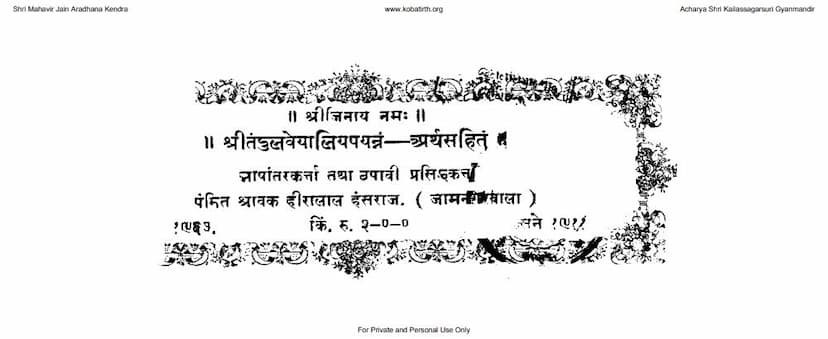Tandul Vaiyalia Payanna Sarth
Added to library: September 2, 2025

Summary
This comprehensive summary is based on the provided Jain text, "Tandul Vaiyalia Payanna Sarth," authored by Shravak Hiralal Hansraj. The text, presented in Gujarati with an accompanying explanation, delves into various aspects of Jain philosophy, focusing on the human body, life cycles, and the importance of righteous conduct.
Key Themes and Content:
-
The Human Body and its Impermanence: A significant portion of the text is dedicated to describing the human body in great detail, often emphasizing its impure and transient nature. It enumerates various bodily parts, fluids, and functions, frequently highlighting their origins in blood and semen, and their susceptibility to decay and disease. The text uses numerous analogies and vivid descriptions to underscore the idea that the physical body is ultimately a vessel of suffering and impurity.
-
Life Cycles and Rebirth: The text touches upon the concept of rebirth within Jainism. It discusses the process of conception and development within the womb, detailing the stages of fetal growth and the eventual birth. The cyclical nature of life, death, and rebirth is implicitly and explicitly mentioned.
-
The Nature of Existence: The text critiques attachment to worldly pleasures and sensory experiences. It describes the ephemeral nature of happiness derived from physical beauty, wealth, and sensual pursuits, often contrasting them with the ultimate suffering that these attachments can lead to. The text emphasizes the fleetingness of youth and the inevitability of old age and death.
-
The Path to Liberation (Moksha): A central message of the text is the importance of understanding the true nature of reality and detaching oneself from worldly illusions. It advocates for the practice of Dharma (righteous conduct, religious observance) as the sole means to achieve liberation from the cycle of suffering. The text extols the virtues of non-violence, self-control, and spiritual knowledge.
-
Critique of Worldly Attachments and Illusions: The text often uses stark and sometimes graphic descriptions to illustrate the vanity of worldly possessions, physical beauty, and sensual pleasures. It portrays women, in particular, as a source of worldly attachment that can lead to downfall, analyzing their various attributes and allurements as traps for the unwary. The text also critiques the pursuit of wealth, social status, and physical adornments as ultimately futile in the face of impermanence and suffering.
-
The Importance of Right Conduct and Spiritual Knowledge: The text repeatedly stresses the significance of adhering to Jain principles, particularly Dharma, as the only way to attain true happiness and liberation. It highlights the role of spiritual knowledge and understanding in overcoming ignorance and attachment. The text encourages introspection and detachment from the physical body and the material world.
-
Detailed Anatomical and Physiological Descriptions: The text provides extensive details about the human body's internal workings, including the number of bones, joints, muscles, nerves, and other bodily elements. It discusses the formation of the fetus, the process of respiration, and the quantities of various substances consumed or produced by the body over a lifetime. These descriptions, while detailed, often serve to emphasize the complexity and often unpleasant realities of the physical form.
-
The Concept of Time and its Measurement: The text also engages with the concept of time, breaking it down into units such as breaths, moments, and years, and providing calculations for these durations. This aspect likely serves to underscore the vastness of time and the relative insignificance of a single human lifespan in the grand scheme of existence.
-
The Role of the Spiritual Guide: The text's structure, involving dialogue between a spiritual teacher (Lord Mahavir, implied) and a disciple (Gautam Swami), highlights the importance of a Guru or spiritual guide in imparting knowledge and leading individuals on the path to spiritual realization.
Overall Message:
"Tandul Vaiyalia Payanna Sarth" is a profound exposition on the ephemeral and often suffering-filled nature of worldly existence. It serves as a strong call to detachment from physical attachments, sensual desires, and worldly illusions. The ultimate message is to embrace Dharma, cultivate spiritual knowledge, and strive for liberation from the cycle of birth and death, thereby attaining eternal peace and bliss. The detailed descriptions of the human body, while sometimes stark, are intended to foster a sense of renunciation and encourage a focus on spiritual liberation.